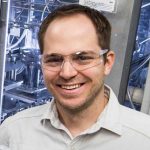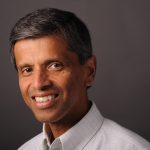Dielectric Science & Technology Thomas Callinan Award
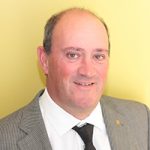 Monday 1010h | Vancouver Convention Center, Room WMR 116
Monday 1010h | Vancouver Convention Center, Room WMR 116
Materials and Processes as Enablers for Moore Moore and Beyond Moore Technologies
by Stefan De Gendt
Stefan De Gendt is a scientific director at imec (Interuniversity Microelectronics Centre), an R&D hub for nano and digital technologies. He is responsible for research on the chemistry and physics of exploratory materials. He joined imec as a researcher in the Ultra Clean Processing Group in 1996, working on topics including cleaning technology and analytical metrology for contamination control in CMOS (complementary metal–oxide–semiconductor) processing. In 2002, he became a group manager at imec and program manager of the imec Industrial Affiliation Program (IIAP) on high-k and gate metal materials, working to replace conventional SiO2-based gate dielectrics (by metaloxide high-k materials) and Si based gate electrodes (by metal materials) to allow further scaling of transistor technologies. De Gendt assumed responsibility for imec’s post-CMOS Nanotechnology program in 2005. This program’s goal was the exploration of devices using 1D (nanowire-like) architectures; synthesis and use of carbon nanotubes for exploratory interconnect applications; and exploration of graphene synthesis and applications. Currently De Gendt oversees material- and process-related research on a wide variety of exploratory materials for CMOS and memory technology.
De Gendt obtained his PhD from Universiteit Antwerpen in 1996. Today, he is associated on a part-time basis with the Department of Chemistry at Katholieke Universiteit Leuven where he has coached more than 15 postdocs and PhD students (more than 20 graduated since 2006; 10 are currently in progress; and an average of three research students per year). He is the co-author of more than 400 technical papers in refereed journals and co-inventor of cleaning and gate stack process steps, resulting in several patent applications. De Gendt has been actively involved since 2004 in the organization of international conferences (primarily with ECS) on high-k gate stack, carbon nanotubes, graphene, and III-V materials and atomic layer deposition. At IEDM (International Electron Devices Meeting), he served in numerous roles leading to the position of General Chair. De Gendt is a member at large of the ECS Dielectric Science and Technology Division and ECS Electronics and Photonics Division, as well as the ECS Europe Section. He served as technical editor for the ECS Journal of Solid State Science and Technology from 2011 to 2017; Senior Vice President of ECS from 2017-2020; and ECS President from 2020-2021.
Electronics and Photonics Division Award
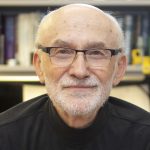 Tuesday 0900h | Vancouver Convention Center, Room WMR 111
Tuesday 0900h | Vancouver Convention Center, Room WMR 111
Let There be Light; Research at the Intersection of Electronics and Photonics
by Andrew Steckl
Andrew Steckl is Ohio Eminent Scholar, Carl Gieringer Professor, and Distinguished University Research Professor at the University of Cincinnati (UC) in the Departments of Electrical Engineering and Computer Science; Biomedical Engineering; and The Materials Science and Engineering Program, Department of Mechanical and Materials Engineering. He is the Founder and Director of the UC Nanoelectronics Laboratory. His current research activities focus on biosensors; microfluidic lab-on-chip devices; and electrospinning of complex nanofibers and related membrane chem/bio/med applications.
Prof. Steckl obtained his BS degree from Princeton University and his MS and PhD degrees from University of Rochester. After several years in industrial R&D, he joined Rensselaer Polytechnic Institute in 1976 as a faculty member in the Electrical and Computer Engineering Department, where he founded the Center for Integrated Electronics, a multi-disciplinary campus-wide activity. At UC since 1988, Prof. Steckl has graduated 47 PhD students and has supervised 13 post-doctoral fellows. With his students, he has published ~ 440 papers which have received over 13,000 citations to date with an h-index of 61. Prof. Steckl has 26 patents on various electronic materials and devices. He is a Life Fellow of the Institute of Electrical and Electronic Engineering (IEEE), Fellow of the National Academy of Inventors, and Fellow of American Association for the Advancement of Science (AAAS). He received the 2020 ECS Electronics and Photonics Division Award.
Electronics and Photonics Division Award
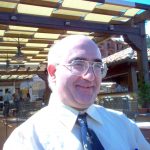 Tuesday 0810h |Vancouver Convention Center, Room WMR 111
Tuesday 0810h |Vancouver Convention Center, Room WMR 111
The Impact of Defects on the Performance of Semiconductor Devices and Materials
by Eddy Simoen
Eddy Simoen is a senior researcher at imec, where he is currently involved in the study of defect and strain engineering in high-mobility and exitaxial substrates and defect studies in germanium and III-V compounds. His research interests cover the field of device physics and defect engineering in general, with particular emphasis on the study of low-frequency noise, low-temperature behavior and radiation defects in semiconductor components and materials. In these fields, he has either authored or co-authored over 1,800 journal and conference papers, and 12 book chapters. His monographs and books that have been translated into Chinese include Radiation Effects in Advanced Semiconductor Devices and Materials and Germanium-based Technologies – from Materials to Devices. Prof. Simoen has organized many workshops and symposia.
Prof. Simoen completed his PhD in Engineering in 1985 at Ghent University then joined imec in 1986 to work in the field of low temperature electronics. In 2013, he was named part-time professor at Ghent University and also received a visiting professorship at the Beijing Institute of Microelectronics. Prof. Simoen is the lead organizer of the biannual High Purity Silicon Symposium at ECS meetings and in 2016 was named Fellow of The Electrochemical Society. An IEEE Senior Member, he has served as Chair of the IEEE EDS Chapter Benelux since 2016. He is a member of the Editorial Board of Semiconductor Science and Technology.
Energy Technology Division Graduate Student Award sponsored by BioLogic
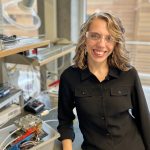 Monday 1450h | Vancouver Convention Center, Room WMR 212
Monday 1450h | Vancouver Convention Center, Room WMR 212
Design Principles for High-performance and Durable Anion Exchange Membrane water Electrolyzers
by Grace Lindquist
Grace Lindquist is a fourth-year PhD candidate at the University of Oregon (UO) working under the advisement of Prof. Shannon Boettcher. Her graduate work focuses on improving the performance and degradation of anion exchange membrane (AEM) water electrolysis in pure water using non-platinum group metal (PGM) catalyst materials. Using advanced electrochemical and analytical techniques, she works to characterize catalyst and ionomer degradation in these systems and develop mitigation strategies to prevent these pathways and improve durability.
Lindquist earned her BA in Chemistry from the College of Saint Benedict and Saint John’s University. In 2020, as an intern with Nel Hydrogen, she worked to advance AEM technology and gained valuable technoeconomic insight into her work. Her results are in Joule, ACS Applied Materials and Interfaces, ACS Energy Letters, and other publications. She was featured in ACS Energy Letters’ 2022 series, “Women Scientists at the Forefront of Energy Research.” Outside of the lab, she is a director for Mad Duck Science, an outreach program that hosts science experiments for middle school students, and outreach coordinator for UO Women in Graduate Science.
Energy Technology Division Graduate Student Award sponsored by BioLogic
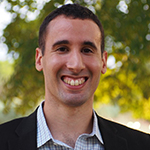 Wednesday 0800h | Vancouver Convention Center, Room WMR 207
Wednesday 0800h | Vancouver Convention Center, Room WMR 207
Voltage as a Driving Force for Ammonia Activation
by Zachary Schiffer
Zachary Schiffer recently joined the Atwater Lab at the California Institute of Technology as a Postdoctoral Scholar working on photo(electro)catalytic nitrogen reduction and devices for carbon capture. He completed his PhD in 2021 with Prof. Karthish Manthiram at the Massachusetts Institute of Technology Department of Chemical Engineering. His thesis explores electrification and decarbonization routes for industrial chemical processes with a focus on the development of electrochemical routes for ambient-condition nitrogen cycle reactions. In general, his research combines fundamental thermodynamics, kinetic analysis techniques, computational chemistry, and materials synthesis to explore electrochemical systems. For his Princeton University Chemical and Biological Engineering BSE senior thesis, he researched the mechanics of Li-ion batteries with Prof. Craig Arnold.
Energy Technology Division Research Award
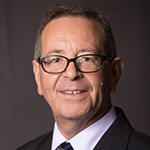 Monday 1400h | Vancouver Convention Center, Room WMR 212
Monday 1400h | Vancouver Convention Center, Room WMR 212
Interplay between Synthesis, Mechanisms and Performance of Electrocatalysts and Ionomers for Ion-Exchange Membrane Fuel Cells
by Vito Di Noto
Vito Di Noto is a Full Professor of Electrochemistry for Energy and Solid State Chemistry in the Department of Industrial Engineering at the Università degli Studi di Padova (UNIPD). He is Head of the Section of Chemistry for Technology in the same department, and founder and team leader of the research group, Chemistry of Materials for the Metamorphosis and the Storage of Energy – CheMaMSE. Prof. Di Noto has more than 30 years of experience in the research and development activities of advanced functional materials for electrochemical energy conversion and storage devices, including ion-exchange membrane fuel cells, and primary and secondary batteries running on alkaline and alkaline-earth elements. In the late 1990s, he pioneered the secondary magnesium ion battery and devised breakthrough approaches for the synthesis of electrolytes and electrode materials. He also provided seminal contributions to the understanding of the mechanisms of ion conduction in condensed phases.
Prof. Di Noto received his PhD in Chemistry from UNIPD in 1992, then joined the faculty there. He has published more than 315 papers and 30 patents. Most of these were licensed to private companies and led to the development of products for application in the field of electrochemical energy conversion and storage (e.g., electrolyzers, electrocatalysts) that are commercialized all over the world. His work attracted more than 8000 citations with an h-index of 49. Prof. Di Noto was recently included in the Stanford University list of the Top Two Percent of Scientists in the World. A Fellow of The Electrochemical Society and Fellow of the Japan Society for the Promotion of Science, Prof. Di Noto serves as President of the Italian Chemical Society’s Electrochemistry Division. He is highly involved in organizing research on fuel cells and batteries at the European Union level, taking an active role in top-notch supranational coordination.
Energy Technology Division Supramaniam Srinivasan Young Investigator Award
Monday 1120h | Vancouver Convention Center/Room WMR 217
Materials and Capability Development in Photo- and Electro-chemical Electrons-to-Molecules (E2M) Device Research
by James L. Young
James L. Young is a Scientist at the National Renewable Energy Laboratory (NREL) in the Electrosynthesis and Fuels Storage Science & Engineering Group. He leads NREL’s HydroGEN Consortium PEC projects; the H2NEW Consortium membrane electrode assembly performance ex-situ characterization task; a technology commercialization project on low-cost electrolysis diffusion media materials; and a Laboratory Directed Research and Development (LDRD) project on electrochemical ammonia synthesis.
Dr. Young received his BS from the University of Illinois at Urbana-Champaign. Though his original interest was in semiconductors and solid state electronic properties of materials, as a 2010 undergraduate intern at NREL, his focus shifted toward electrochemical research. He completed his PhD in Materials Science and Engineering at the University of Colorado-Boulder (CU-Boulder). There he developed tandem III-V PEC devices and atomic-layer-deposited thin films as protective, anti-reflective, and catalytic coatings co-advised by Drs. Steven George (CU-Boulder) and Todd Deutsch (NREL). Dr. Young continued PEC work as a postdoc while contributing to low-temperature electrolysis research projects advised by Dr. Guido Bender. Dr. Young joined NREL in 2018.
Industrial Electrochemistry and Electrochemical Engineering Division Student Achievement Award
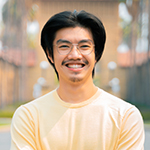 Tuesday 0800h | Vancouver Convention Center, Room WMR 206
Tuesday 0800h | Vancouver Convention Center, Room WMR 206
Reactive Separations to Remediate and Valorize Nitrogen-Polluted Wastewaters
by Matthew Liu
Matthew Liu is a PhD student in the Chemical Engineering Department at Stanford University and a NASA Space Technology Graduate Research Fellow. Liu researches electrochemical reactive-separation processes to recover ammonia from nitrogen-rich wastewaters as a member of William Tarpeh’s lab. His particular focus is on electrocatalytic nitrate reduction, which has led him to investigate systems driven by heterogeneous catalysis, molecular catalysis, and single atom catalysis. Liu is also interested in how the structure and composition of the microenvironment at the electrode-electrolyte interface directs nitrate reduction performance. As an undergraduate studying at the University of California, Berkeley and researching at Lawrence Berkeley National Laboratory, he also focused on energy and the environment, studying free-radical chemistry in aqueous aerosol under Frances Houle and electrochemical carbon dioxide reduction under Bryan McCloskey.
Nanocarbons Division Richard E. Smalley Research Award
Wednesday 1400h | Vancouver Convention Center, Room WMR 202
Evolution of Nanocarbons in Energy Conversion and Storage
by Prashant V. Kamat
Prashant V. Kamat is a Rev. John A. Zahm, C.S.C., Professor of Science in the University of Notre Dame Department of Chemistry and Biochemistry and Radiation Laboratory—and Concurrent Professor in the Department of Chemical and Biomolecular Engineering. Prof. Kamat works to build bridges between physical chemistry and material science to develop advanced nanomaterials that promise cleaner and more efficient light energy conversion. He has directed DOE funded solar photochemistry research for the past 35-plus years. In addition to large multidisciplinary interdepartmental and research center programs, he has actively worked with industry-sponsored research and served on many national panels on nanotechnology and energy conversion processes.
Prof. Kamat earned his PhD in in Physical Chemistry in 1979 from Bombay University and completed postdoctoral research at Boston University (1979-1981) and the University of Texas at Austin (1981-1983). He joined Notre Dame in 1983. Prof. Kamat has published more than 500 scientific papers with 76,000 citations and an h-index of 141. Thomson-Reuters featured him as one of the most cited researchers each year from 2014-2021. He is currently Founding Editor-in-Chief of ACS Energy Letters and advisory board member of several scientific journals. He served as deputy editor of the Journal of Physical Chemistry Letters. From 2000-2004, Prof. Kamat was Chairman of the ECS Fullerene (now Nanocarbon) Division. He is a Fellow of The Electrochemical Society, American Chemical Society, and American Association for the Advancement of Science, and Pravasi Fellow of the Indian National Science Academy. He received the 2013 Langmuir Lectureship Award; 2011 Chemical Research Society of India Medal; and 2006 Japanese Photochemical Society Honda-Fujishima Lectureship Award.
Nanocarbons Division SES Young Investigator Award
 Wednesday 1000h | Vancouver Convention Center, Room WMR 204
Wednesday 1000h | Vancouver Convention Center, Room WMR 204
Synthetic Biology Approaches for Overcoming Bottlenecks in Optical Nanocarbon Technologies
by Ardemis Boghossian
Ardemis Boghossian is a tenure-track assistant professor at the École Polytechnique Fédérale de Lausanne (EPFL) where she started in 2015 as the lead principal investigator of the Laboratory of NanoBiotechnology. Her laboratory implements a highly interdisciplinary approach to addressing fundamental challenges and developing novel technologies that exploit the synergy between nanotechnology and synthetic biology. Through her focal points in the fields of optoelectronics and protein engineering, she contributes new biological and biochemical methods for the production of durable hybrid nanomaterials for energy and biosensing applications.
Prof. Boghossian earned her BSE in Chemical Engineering from the University of Michigan in 2007 and completed her PhD in Chemical Engineering at the Massachusetts Institute of Technology in 2012 under the supervision of Michael S. Strano. Her graduate work focused on applied nanotechnology, where she engineered nanoparticles that interface with light-harvesting, biological constructs to enhance solar energy conversion. She also developed algorithms for quantifying stochastic fluctuations in fluorescence from single-molecule, nanotube-based biosensors. As a Postdoctoral Fellow at the California Institute of Technology in the laboratory of the 2018 Nobel Laureate Frances H. Arnold, she worked as a protein engineer applying methods of directed evolution to engineer cells that can electronically interface with electrodes.
Organic and Biological Electrochemistry Division Manuel M. Baizer Award
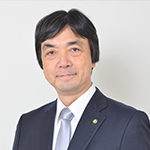 Monday 1450h | Vancouver Convention Center, Room WMR 107/108
Monday 1450h | Vancouver Convention Center, Room WMR 107/108
Electron-Transfer-Triggered Smart Reactions Boost a Better Anthropocene
by Kazuhiro Chiba
Kazuhiro Chiba is the President of Tokyo University of Agriculture and Technology (TUAT); Program Director of the Moonshot Goal # 5 Research & Development Program, Cabinet Office of Japan; and Cooperative Member of the Science Council of Japan. His early research focused on the synthesis and structure elucidation of natural products. Recently, he made important contributions in the explorations of new electrochemical organic reactions and their applications towards biologically active compounds especially in the field of peptides.
Dr. Chiba completed his BA (1981) and MS (1983) degrees in the TUAT Department of Agricultural Chemistry. After serving as a researcher at an industrial research center for seven years, he joined TUAT as Assistant Professor. He received his PhD degree in 1991, spent 1999-2000 working with Prof. K. D. Moeller at Washington University, and was promoted to professor in 2004. During his 30-plus years with TUAT, he contributed to the education and research activities of many undergraduate and graduate students, as well as fostering university-launched startups and entrepreneurship education. Prof. Chiba has authored or coauthored over 200 scientific papers with an h-index of 31. He received the The Electrochemical Society of Japan’s 2006 Journal Award.
Organic and Biological Electrochemistry Division Manuel M. Baizer Award
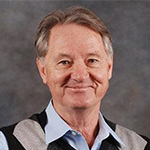 Monday 1400h | Vancouver Convention Center, Room 107/108
Monday 1400h | Vancouver Convention Center, Room 107/108
A Perspective on Organic Electrochemistry
by R. Daniel (Dan) Little
Daniel (Dan) Little is Distinguished Research Professor at the University of California, Santa Barbara (UCSB). His interests span a wide range of topics that presently include electron transfer, green electrochemistry, applications of redox chemistry to synthesis, redox mediated processes, the development of polymer and dendrimer-based redox mediators, applications of quantum mechanical tools to aid in understanding redox chemistry, and the relationship between redox reactions and the expression of bioactivity. He thoroughly enjoys teaching and is passionate about incorporating organic electrochemistry into the undergraduate and graduate curriculum.
Prof. Little earned his PhD in Chemistry from the University of Wisconsin—his home state—in 1974 under Howard Zimmerman. Before that, he completed his BS degree in Chemistry and Mathematics at the University of Wisconsin, Superior, at which time he also carried out undergraduate research at the University of South Dakota and Argonne National Laboratory with L. Kaplan and K. E. Wilzbach. He completed postdoctoral studies with Jerome Berson at Yale University and joined the faculty of UCSB in 1975. Little is grateful to Manuel Baizer for nurturing his interest in electrochemistry when Baizer was an Adjunct Professor at UCSB.
During his 41 years at UCSB, Prof. Little mentored 144 researchers including 55 graduate students, 55 undergraduate researchers, and 34 postdocs and visiting scholars. He is the recipient of numerous awards over the years including the 2016 ISE Jaroslav Heyrovsky Prize for Molecular Electrochemistry; Fellow of the AAAS (1994); 1981 Sloan Fellowship; and 1980 Harold J. Plous Award. He thanks his dedicated and exceptionally talented students whose contributions made it possible for him to publish extensively and lecture throughout the world. Their efforts formed the foundation for his many accolades.






